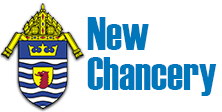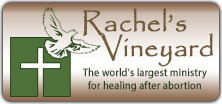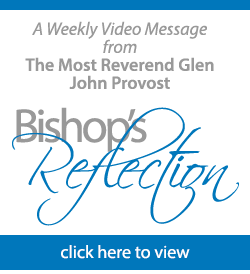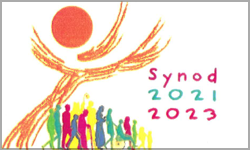According to standard practice, all bishops of the Catholic Church are required to visit the Holy See and submit a report on the work of the Church in their respective dioceses. Because of the transition between the Pontificates of Pope Benedict XVI and Pope Francis, the ad limina visit for the bishops of the United States was delayed to seven years. Hence, from the beginning of November 2019 thru February of 2020, all bishops in our nation will be visiting the Holy Father, the tombs of the Apostles, and the offices of the Vatican which oversee the work of the Church throughout the world.
A high point of the ad limina visit is the celebration of Masses at the four major basilicas in Rome, St. Peter’s where St. Peter is buried, St. Paul outside the Walls where St. Paul is buried, St. Mary Major, which is the oldest church in the West dedicated to the Blessed Virgin Mary, and St. John Lateran dedicated to St. John the Baptist and the Cathedral Church of the Diocese of Rome. Our seminarians from Lake Charles joined the approximately 25 bishops in Region V, which contains all dioceses in the States of Louisiana, Mississippi, Alabama, Tennessee and Kentucky. Praying together at the tombs of the apostles was a deeply moving experience for all of us. Here the successors of the apostles, that is the bishops, prayed together for the church, their dioceses, and the flocks entrusted to their care.
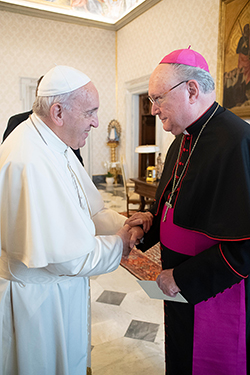
Another very special moment was the visit with the Holy Father. In 2012, my last ad limina visit, we met with Pope Benedict XVI as a Province, fewer than 10 bishops, for about an hour. On this occasion with Pope Francis, two regions of bishops met with the Holy Father, approximately 40 bishops, for almost three hours. In spite of the size of the group, Pope Francis invited conversation and questions. The entire experience was exceptional in many ways. There was humor, frank discussion, and an informative sharing of opinion on diverse topics.
Earlier in the year, the diocese had presented its ad limina report, an almost 100 page document detailing the pastoral and administrative efforts of the Diocese of Lake Charles. This gave an opportunity for the various departments of the Holy See to study and read what was going on here in the local Church. There was evidence that they had done just that.
Every day of the ad limina was set aside for visits to the various congregations and commissions that make up the Vatican or Holy See. The Holy See has an office for education, doctrine, laity and family life, clergy, religious, liturgy, culture, protection of minors and youth, evangelization, foreign affairs, and bishops, to name the most prominent. Here the visiting bishops could voice their own concerns in these areas and receive input from the heads of these congregations and commissions. The entire experience was most enlightening.
The typical visit to a congregation usually followed this format. First, a bishop, serving as spokesman, introduced the group and gave some sort of introduction. Then, the head of the congregation or diocesan office introduced his personnel and gave an overview of their work, which included their concerns. At this point, the floor was opened for questions from the visiting bishops and discussion ensued. These sessions usually lasted from one to two hours.
Many Catholics do not know that the Holy See or the Vatican, as it is commonly called, is a sovereign state, with its own government and laws. Thus, this Vatican City State maintains diplomatic relations with over 170 ambassadors, called nuncios, throughout the world. Therefore, the Secretary of State conducts the foreign policy affairs of the Vatican City State. Our meeting with the Cardinal Secretary of State was most interesting because we heard of concerns in areas that are mentioned in daily news sources.
Also, many Catholics do not know that the Holy See has a special commission to address the protection of minors and vulnerable adults. Here the issues of human trafficking, slavery, and the response of the Church to these problems are reviewed with guidance given to the Pope on matters that need action.
Of course, this subject of protection for our children is of utmost concern. Throughout the weeklong stay in Rome, we were in discussion on ways to address the problem. There has been much progress made. There is much left to be done. I am confident we, both the Church in general and the Diocese in particular, are moving ahead. What steps have been taken already must be strengthened. For example, the commitment of this Diocese of Lake Charles to cooperate fully with the civil authorities and create a safe environment for our youth and young adults is first and foremost. I think we have shown consistently through concrete actions our willingness to work with law enforcement and government officials. We have made this pledge to our people, and we are committed to this transparency.
In summary, our last act as a group of bishops on the ad limina was to celebrate Mass at the tomb of St. Paul. The imposing Basilica of St. Paul outside the Walls is the resting place of the Apostle to the Gentiles. In this secular world I felt that it was an appropriate place for us, who are the successors of the apostles, to visit. St. Paul confronted a pagan world himself. Through his writing and preaching he gave witness to the Holy Spirit working through him to bring his listeners to Jesus Christ. Joining with my brother bishops, praying at the tomb, celebrating Holy Mass, along with three young men of Lake Charles who will be ordained to the Holy Priesthood next June, brought to completion this visit to the Holy City of Rome. Stained by the blood of martyrs, Rome has witnessed two thousand years of Church history. We find in Rome the tombs of countless saints who witnessed to Jesus Christ. She has seen the up-and-down movement of the Gospel’s preaching, but
she has always moved forward. She cannot help but do this. She is the burial place of the Prince of the Apostles. She is the seat of unity for those who seek to bring the message of Christ into the 21st Century. I remembered the intentions of the faithful of the Diocese at each holy place, and I thank God for the opportunity to have made this visit once again. In this way, each and every one was with me on holy ground.

